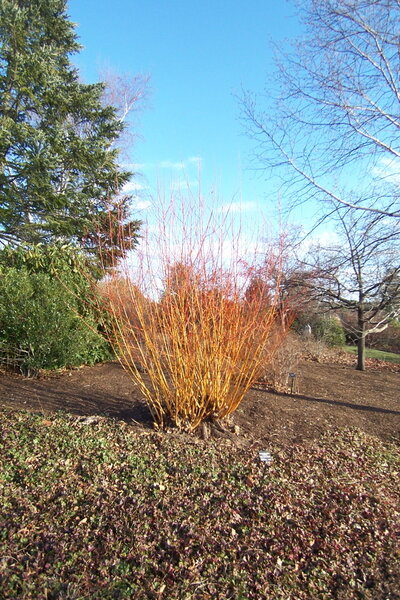A colorful willow shrub for winter
Loading...
Recently I had a chance to visit a friend in Massachusetts. One afternoon we visited one of our favorites, the Tower Hill Botanic Garden.
As we drove in, I saw this orange-coral-golden beauty and thought it was the shrubby dogwood ‘Midwinter Fire’.
I love the color of this plant in the winter landscape, but in Virginia it suffers from leaf spot during the summer. So placement is important – back of the border where other tall perennials will shield it from my view during its awkward period.
I was wrong about the Tower Hill plant, though.
It was a willow – Salix alba ‘Britzensis. What a beauty! In the winter light it glowed. [See first photo at left.]
Other unusual willows
I have grown a couple of other willows:
- The poodle-like Salix babylonica ‘Crispa’ – a weeping willow in all respects except that the leaves are tight curls.
- The amazingly weird Salix sachaliensis ‘Sekka’, a deformed willow that has a fasciating virus that causes the branches to widen and curl (beloved by flower arrangers). [See second photo at left.]
- And let’s not forget the ghost willow, Salix integra ‘Hakuro Nishiki’, so beautiful in spring with pink and white foliage.
I know they must all be pruned heavily to remain beautiful and not take over the landscape.
Fascinating fasciation
The only one that has a little pussy willow in its nature is the ‘Sekka’, and seeing the little furry buds on the strangely deformed stems is odd, like fasciation itself. Every once in a while I will see an Amsonia hubrichtii (blue star) with some fasciation. Viral but not fatal.
One year when there was a lot of rain, ‘Sekka’ outgrew the fasciation and produced normal stems. But in this part of Virginia, that’s rare. Most often, it is otherworldly and wonderful.
Back to ‘Britzensis’. I told several friends about this and went looking on the Internet for sources. I found rooted cuttings in Canada. I don’t understand why it's not more widely available, as this is a spectacular plant in winter.
Maybe it has a secret, like the dogwood. But I can’t wait to try it here in Virginia and wow the neighbors and myself. I'm easily amused, I guess.
-----
Donna Williamson blogs regularly at Diggin' It. She's a master gardener, garden designer, and garden coach. She has taught gardening and design classes at the State Arboretum of Virginia, Oatlands in Leesburg, and Shenandoah University. She’s also the founder and editor of Grandiflora Mid-Atlantic Gardening magazine, and the author of “The Virginia Gardener’s Companion: An Insider’s Guide to Low Maintenance Gardening in Virginia.” She lives in the Shenandoah Valley of Virginia. To read more by Donna, click here.






